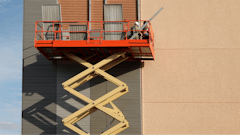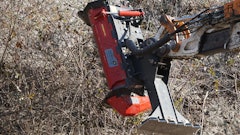
Seismic disruptions brought by the COVID-19 pandemic have pressured major industries, including the construction sector, to accelerate their digital transformation initiatives. Along with the need to grow and morph into digitally able enterprises, the pandemic has forced businesses to implement remote work arrangements to ensure the continuity of operations.
This shift from the office to remote work has shone a light on the state of deskless workers, who make up around 2.7 billion people, or approximately 80 percent of the labor market. While comprising a supermajority of the global workforce, deskless workers have been performing their jobs with devices, software and other technology designed for the office-based employee.
This problem has been prevalent for years, but it wasn't until COVID-19 that this massive technology gap received great attention. In the coming months and years, equipment rental companies will find opportunities in providing deskless workers the deskless tech they need.
Dedicated deskless tech matters
The construction industry is the fourth biggest deskless-heavy industry, with an estimated 265 million infrastructure engineers, drivers, equipment operators and contractors to name a few. The figure puts it behind only agriculture (858 million), retail (497 million) and manufacturing (427 million).
With so many deskless employees in major industries, it’s perplexing why such a large demographic has been technologically underserved for so long. In the State of Technology for the Deskless Workforce study, 75 percent of deskless workers reported utilizing technology to perform their tasks and accomplish their goals.
Despite these high levels of usage, employers aren’t quick to invest and equip their non-desk workers with tools and software that are effectively designed for them. About 83 percent of respondents say their management provided them with desktops and laptops. Given the mobile nature of their profession, these office-based devices are far from ideal, as they tether them to a desk, totally restricting their movement and effectiveness.
According to the same research, 70 percent of respondents believe that more and better technology would help increase their efficiency and productivity. Investing in dedicated deskless tech will impact the overall effectiveness of multiple key business areas, such as communications, onboarding, training, operations and logistics.
The impact of deskless tech on equipment rentals
Equipment rental companies are poised to benefit from equipping their personnel with deskless technology.
Renting equipment can be a long, mundane process if the renter has to go through things manually, such as requiring clients to fill out paper forms. With a mobile-native business app, rental agents can take all the necessary information from customers using their smartphone or tablet and upload all that details into the company's CRM directly from the site. It streamlines the whole process while delivering quality service and experience to customers.
Another benefit is that existing customers who have rented the same equipment multiple times no longer have to go through the same repetitive, predictable cycle. Rental representatives can quickly have the same item rented out to repeat clients with a few taps on their mobile phone or tablet.
Monitoring rented assets in the field, at project sites, is a challenge shared by both the owners and the renters. The complexity of tracking — which can be extended to monitoring the utilization of the asset — grows multifold with larger projects that involve multiple sites. Without geo-tracking and geo-fencing capabilities to automate various process workflows and trigger notifications, management becomes a real challenge.
Aside from monitoring rented assets in the field and streamlining the rental process, leveraging deskless tech helps improve attendance monitoring. Employees can check in and check out using dedicated, tailored mobile apps. GPS and time tracking capability can record an employee's work hours and location, greatly enhancing job-cost accuracy and accounting.
Office-based managers and team leaders benefit from the flexibility, accuracy and visibility deskless tech brings. In particular, this deskless visibility improves their control over decision-making and scheduling. Project managers can review reports and requests received from field representatives in real-time, enabling them to review the items, prioritize and approve rentals without waiting for their staff to return to the office.
Time to act
Since the onset of the COVID-19 pandemic, enterprises have accelerated their digital transformation projects and adopted new technologies to achieve resilience and ensure business continuity in these hard times. However, 65 percent of non-desk employees say their organization's digital transformation initiative did not include them. They reported that they have not been equipped with additional, better technology suited to their roles and responsibilities.
Around 60 percent of deskless workers are dissatisfied with the technology they've been given or believe that there is a massive room for growth as far as technology at work is concerned. Enterprises need to recognize this if they are to thrive in an economy that is leaning towards a deskless model.
For one, dissatisfaction scores are already high in essential industries, primarily in construction, healthcare, education, manufacturing and retail. The failure to address this technology gap can and will further drive turnover rates in deskless-loaded sectors.
Second, more than half (56 percent) of deskless workers have resorted to using consumer-grade communication apps and other tools to perform their tasks. One-third have purchased their own software and hardware with the sole purpose of simplifying their work. The use of unauthorized applications and hardware may streamline a deskless worker's tasks; however, it also exposes them and their whole organization to a load of security and compliance risks.
Third, technology has now become a major factor in attracting and retaining employees. Over three-fourths of deskless employees reveal that they now consider the technological capabilities and availability of a company before deciding to join them or look somewhere else. In a business landscape where deskless workers number to almost three billion, companies would be wise to improve their technology and invest in deskless apps and tools.
Cultivating your remote workforce
The demand for deskless workers is anticipated to grow in the coming years as the entire world moves on from the COVID-19 crisis. Gartner predicts that 74 percent of businesses already have plans to move their employees from office to remote work after COVID-19. By 2025, approximately 70 percent of the entire labor force will be remote-based.
This surging demand needs to be paralleled with deskless technology that is on par with the needs of the modern deskless employee. The equipment rental business will succeed by providing employees with apps and tools that don’t tie them to a desk, but empower them to meet customers where they are.
Deskless workers are the ones who spend most of their time on the front lines and in the field, representing brands and serving customers who are expecting convenience and quality service. Having the best, dedicated deskless tech will enhance their productivity and efficiency, resulting in better service for their customer base and massive growth for their business. This demand will grow in the coming years; rental business owners should be alert to this opportunity.


























